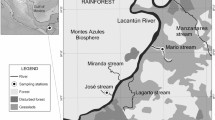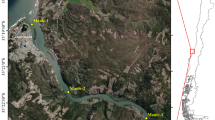Abstract
The aim of this study is to describe general features of sediment, primary producers and both benthic and planktonic consumers in two shallow saline lakes (Salada de La Muerte andSalada de Piñol) in order to detect main factors influencing food web structure.
The lakes are located in Los Monegros district, in the central area of the Ebro River catchment, NE Spain. Both lakes are temporary with salinity well above 30 g L4. Although they are situated close to each other (distance: 300 m), their communities of primary producers differ dramatically. One lake (La Muerte) is dominated by microbial mats and seems to function through the benthic pathway. The other (Piñol) has some macrophytes but phytoplankton is the main source of primary production. Two cycles (1994/95 and 1995/1996), quite different in their hydrological characteristics, have been studied.
PCA demonstrated the major influence of hydrologic features (e.g. water level) over biotic and abiotic parameters. The presence of microbial mats in La Muerte played a key role in stabilizing the sediments. A comparison of food web structure and dynamics in both lakes has been performed and the influence of sediment features is discussed.
Similar content being viewed by others
References
Aminot, A. & Chaussepied, M: 1993, Manuel des analyses chimiques en milieu marin. CNEX, Paris.
Andersen, J.M.: 1976,Water Research 10, 329–331.
APHA (ed): 1989,Standard Methods for the Examination of Water and Wastewater. Washington.
Beboult, B.M.; Fitzpatrick, M.W. & Paerl H.W.: 1993,Appl. Envir. Microbial. 59, 1495–1503.
Casado, S. Florin, M. Mollá, S. and Mantes, C.: 1992,Managing Mediterranean Wetlands and their Birds, IWRB Special Publications No. 20. IWRB & Istituto Nazionale di Biologia della Selvaggina, 56–58.
Downing, J.A. & Rigler, F.H.: 1984, A manual on Methods for the assessment of Secondary Productivity in Fresh Waters. Balckwell Scientific Publications, Oxford, 106–110.
Duarte, C.M.; Bird, D.F. & Kalff, J.: 1988, Verh. Internat. Verein. Limnol.23 (1), 271–281.
Fisher, S.G. and Grimm, N.B.: 1991, Comparative analysis of ecosystems: patterns, mechanisms, and theories. Springer-Verlag, New York, 196–221.
Florin, M., Priebe, Ch. and Besteiro, A.G.: 1994,Verh. Int. Verein. Limnol. 25, 1342–1344.
Florin, M. and Montes, C.: (in press),Proc. Int. Assoc. Limnol. 26
Grimm, N.B. and Fisher, S.G.: 1989, J.N. Am. Benthol. Soc.8, 293–307.
Grimm, N.B. and Fisher, S.G.: 1992, Global climate change and freswater ecosystems, Springer-Verlag, New York, 211–233.
Guerrero, M.C. and de Wit, R.: 1992,Limnetica,8, 197–204.
Guerrero, M.C. Tadeo, A.-B. and de Wit, R.: 1994,Microbial Mats, NATO ASI Series, Vol. G35, 85–90.
Javor, B: 1989,Hypersaline environments. Microbiology and biogeochemistry, Springer-Verlag, London, 328.
Pimm, S.L.: 1982,Food webs. Chapman & Hall, London.
Pimm, S.L. and Lawton, J.H.: 1977,Nature 268, 329–331.
Pueyo, J.J., 1978,Revista Investigaciones Geológicas,34: 195–207.
Pueyo, J.J. & Inglés, M., 1984,Geochemistry and mineral formation in the earth surface. Rodriguez Clemente R. & Tardy, Y. Eds.
Quirantes Puertas, J., 1965,Estudios Geológicos, vol XXVII (4): 355–362.
Reddy, R.: 1994,Copepoda: Calamoida: Diaptomidae, SBP Academic Pub.
Reuter, J.E., Rhodes, C.L., Lebo, M.E., Kotzman, M. And Goldman, C.R.: 1993,Hydrobiologia,267, 179–189.
Scheffer, M. Hosper, S.H. Meijer, M.-L. Moss, B. and Jeppesen, E.: 1993, TREE8(8), 275–278
Symoens, J.J. (ed).:1988,Vegetation of Inland Waters, Kluwer Ac.Pub.
Vymazal, J.1995.Algae and Element Cycling in Wetlands, Lewis Pub.
Williams, W.D.; Boulton, A.J. & Taaffe.: 1990,Hydrobiologia 197: 257–266.
Author information
Authors and Affiliations
Rights and permissions
About this article
Cite this article
Alcorlo, P., Diaz, P., Lacalle, J. et al. Sediment features, primary producers and food web structure in two shallow temporary Lakes (Monegros, Spain). Water Air Soil Pollut 99, 681–688 (1997). https://doi.org/10.1007/BF02406907
Issue Date:
DOI: https://doi.org/10.1007/BF02406907




